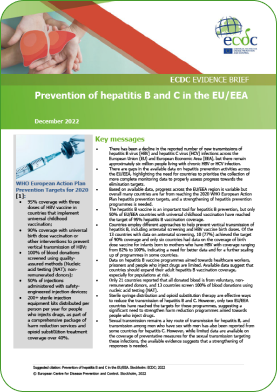Prevention of hepatitis B and C in the EU/EEA
ECDC Evidence brief, December 2022
Key messages
There has been a decline in the reported number of new transmissions of hepatitis B virus (HBV) and hepatitis C virus (HCV) infections across the European Union (EU) and European Economic Area (EEA), but there remain approximately six million people living with chronic HBV or HCV infection.
There are gaps in the available data on hepatitis prevention activities across the EU/EEA, highlighting the need for countries to prioritise the collection of more complete monitoring data to properly assess progress towards the elimination targets.
Based on available data, progress across the EU/EEA region is variable but overall many countries are far from reaching the 2020 WHO European Action Plan hepatitis prevention targets, and a strengthening of hepatitis prevention programmes is needed.


The hepatitis B vaccine is an important tool for hepatitis B prevention, but only 50% of EU/EEA countries with universal childhood vaccination have reached the target of 95% hepatitis B vaccination coverage.
Countries employ different approaches to help prevent vertical transmission of hepatitis B, including antenatal screening and HBV vaccine birth doses. Of the 13 countries with data on antenatal screening, 10 (77%) achieved the target of 90% coverage and only six countries had data on the coverage of birth dose vaccine for infants born to mothers who have HBV with coverage ranging from 82% to 100%, indicating a need for better data and for a further scaling up of programmes in some countries.
Data on hepatitis B vaccine programmes aimed towards healthcare workers, prisoners and people who inject drugs are limited. Available data suggest that countries should expand their adult hepatitis B vaccination coverage, especially for populations at risk.
Only 21 countries reported that all donated blood is from voluntary, nonremunerated donors, and 13 countries screen 100% of blood donations using nucleic acid testing (NAT).
Sterile syringe distribution and opioid substitution therapy are effective ways to reduce the transmission of hepatitis B and C. However, only two EU/EEA countries have reached the targets for these programmes, suggesting a significant need to strengthen harm reduction programmes aimed towards people who inject drugs.
Sexual transmission remains a key route of transmission for hepatitis B, and transmission among men who have sex with men has also been reported from some countries for hepatitis C. However, while limited data are available on the coverage of preventative measures for the sexual transmission targeting these infections, the available evidence suggests that a strengthening of responses is needed.
WHO European Action Plan Prevention Targets for 2020
- 95% coverage with three doses of HBV vaccine in countries that implement universal childhood vaccination;
- 90% coverage with universal birth dose vaccination or other interventions to prevent vertical transmission of HBV;
- 100% of blood donations screened using quality-assured methods (Nucleic acid testing (NAT); non remunerated donors);
- 50% of injections administered with safetyengineered injection devices;
- 200+ sterile injection equipment kits distributed per person per year for people who injects drugs, as part of a comprehensive package of harm reduction services and opioid substitution treatment coverage over 40%.
Find out more about
Erratum: on 6 February 2023 the title of Figure 1 was corrected from ‘Map of hepatitis B and C prevalence in EU/EEA countries’ to ‘Estimates of hepatitis B surface antigen (HBsAg) prevalence in the general population based on pooled estimates of prevalence up to 2021’.
Suggested citation: Prevention of hepatitis B and C in the EU/EEA. Stockholm: ECDC; 2022
© European Centre for Disease Prevention and Control. Stockholm, 2022
